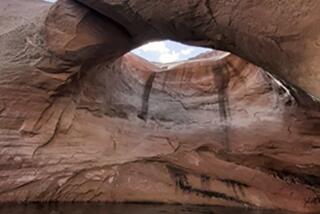Spooky sculptured sandstone
- Share via
Site: Goblin Valley State Park
Where: A remote section of central Utah, between the towns of Hanksville and Green River.
When was this formation created? The rocks are about 170 million years old, dating to the Jurassic era. But erosion has been chiseling the strange shapes only within the last 10 million years.
What geological forces were at work? Erosion. After setting the geologic stage with deposition, burial and lithification (turning the sediments to rock), weathering and erosion worked their magic. Vertical joint or fracture patterns within horizontal sandstone beds created weak spots in the rock. The joints that remained unweathered formed sharp edges and corners that were rounded off by continued wind and rain, giving the goblins their bulbous shapes. Between these horizontal sandstone beds, softer shale and siltstone beds erode more easily. This accounts for the elongated shapes, flat bottoms and pedestals. Variations in the amount or type of cement-like minerals holding the sandstone together may also contribute to the unusual shapes.
What type of materials are we seeing? Turn back the clock about 170 million years and the area that is now Goblin Valley State Park is a wide tidal flat between the sea to the north and continental mountains and hills to the west. Tidal motions were a dominant force in depositing the sandstone, siltstone and shale that make up the goblins. In contrast, the snow-capped mountains nearby are the Henry Mountains, made of igneous rocks that cooled 24 million to 28 million years ago from once-rising magma.
What is significant about this area? The Entrada sandstone has a propensity for forming strange and wondrous land forms. It is the same geologic formation that erodes to arches, fins and spires in Arches National Park and hoodoos in Cathedral Valley of Capitol Reef National Park.
-- Mark Milligan
Geologist, Utah Geological Survey
More to Read
Sign up for Essential California
The most important California stories and recommendations in your inbox every morning.
You may occasionally receive promotional content from the Los Angeles Times.












